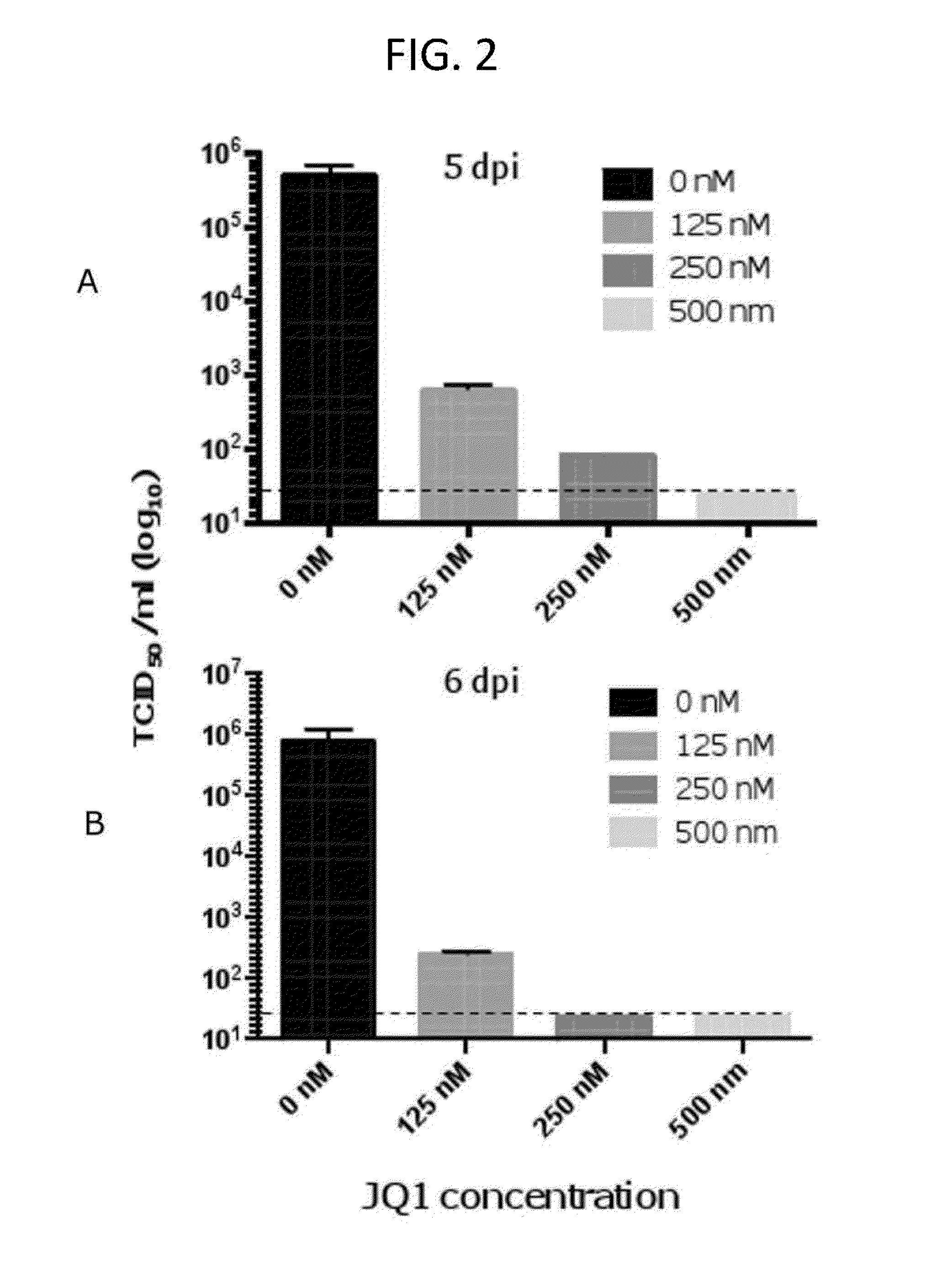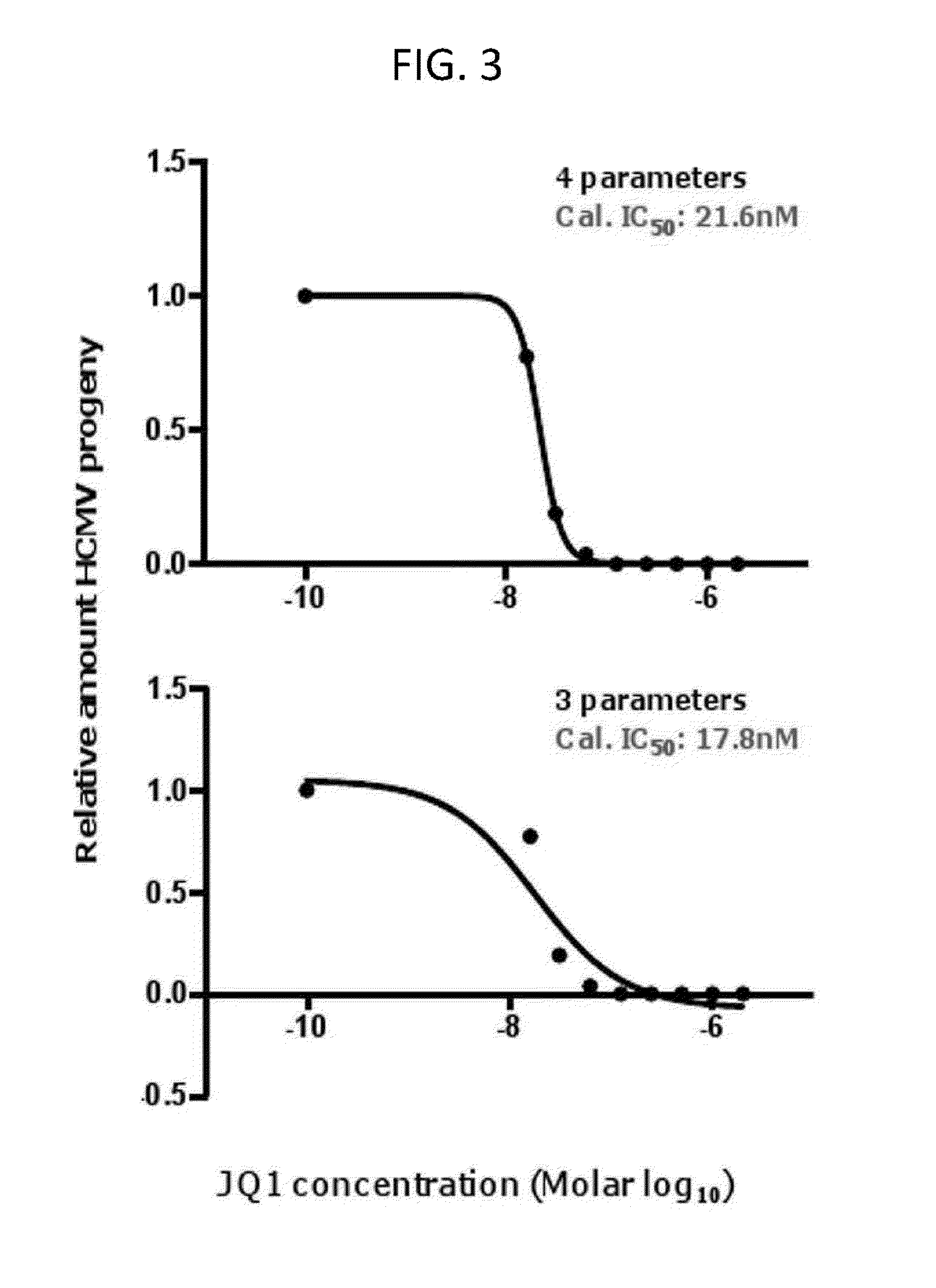Methods of treatment of human cytomegalovirus infection and diseases with bromodomain inhibitors
a technology of bromodomain inhibitors and cytomegalovirus, which is applied in the direction of biocide, heterocyclic compound active ingredients, drug compositions, etc., can solve the problems of not knowing whether bromodomain inhibitors can be used to inhibit hcmv infection, application of bromodomain inhibitors to treat hcmv infection does not disclose us
- Summary
- Abstract
- Description
- Claims
- Application Information
AI Technical Summary
Benefits of technology
Problems solved by technology
Method used
Image
Examples
example 1
[0065]This example demonstrates that HCMV cells lose “cytomegaly” morphology and die upon (+)-JQ-1 treatment.
[0066]In these experiments, human foreskin fibroblasts (HFF) were infected with HCMV, strain AD169, at a multiplicity of infection (MOI) of 3 in the presence or absence of JQ1 (500 nm). Culture media was changed every 24 hours to maintain the concentration of JQ1. Infected cells were examined by phase-contrast or fluorescence microscopy at 72 or 96 hours post infection (hpi). “Cytomegalic” cells appear larger in size with a characteristic intranuclear, homogenous, eosinophilic inclusion which can occupy the entire nucleus of the cell. After 72 hours post-infection in the absence of JQ1, HFF cells displayed a “cytomegalic” morphology (FIG. 1A). While 72 hours after post-infection in the presence of JQ1, HFF cells lost the “cytomegalic” morphology and an accumulation of dead cells was present (FIG. 1A). After 96 hours post-infection in the absence of JQ1, HFF cells displayed a ...
example 2
[0067]This example demonstrates that representative BET bromodomain inhibitor JQ1 inhibits production of HCMV viral progeny.
[0068]In this experiment, the inventors used TCID50 assays to determine the amounts of infectious viral particle in culture supernatants release from HCMV-infected cells, HFFs were infected with HCMV, strain AD169, at an MOI of 3 in the presence of different concentrations of JQ1. Culture media was changed every 24 hours to maintain the concentration of JQ1. At 5 (FIG. 2A) and 6 (FIG. 2B) days post infection (DPI), infected culture media was collected and titers of viral progeny in media was determined by TCID50 assay as described by Perng et al., 2011. The detection limit is indicated by the dashed line. (FIG. 2)
[0069]At 5 days post infection, 125 nM dose of JQ1 reduced the viral titer by approximately 1000 fold (FIG. 2A), increasing the concentration of JQ1 to 250 nM dose further reduced the viral titer and at 500 nM dose of JQ1 the viral titer was undetectab...
example 3
[0071]This example demonstrates that the IC50 of representative BET bromodomain inhibitor JQ1 against HCMV replication is lower than the dose used in anti-cancer experiments.
[0072]HFFs were infected with HCMV, strain AD 169, at an MOI of 3 in the presence of JQ1 at the range of 0-2000 nM. Culture media was changed every 24 hours to maintain the concentration of JQ1. At 5 days post infection, viral titers were determined by TCID50. IC50 (50% viral replication inhibitory concentration) was calculated from the dose response curve using Graphpad Prism 5 software. The calculated IC50 of JQ1 using four parameters was 21.6 nM (FIG. 3A). The calculated IC50 of JQ1 using three parameters was 17.8 nM (FIG. 3B). These calculated IC50 values are much lower than published values used in the treatment of cancer.
[0073]The inventors used TCID50 assays to quantify the IC50 of (+)-JQ-1 in HCMV infection at a MOI of 3 (FIG. 3). The IC50 is lower than the IC50 determined by fluorescence reduction assay...
PUM
| Property | Measurement | Unit |
|---|---|---|
| morphology | aaaaa | aaaaa |
| phase- | aaaaa | aaaaa |
| fluorescence microscopy | aaaaa | aaaaa |
Abstract
Description
Claims
Application Information
 Login to View More
Login to View More - R&D
- Intellectual Property
- Life Sciences
- Materials
- Tech Scout
- Unparalleled Data Quality
- Higher Quality Content
- 60% Fewer Hallucinations
Browse by: Latest US Patents, China's latest patents, Technical Efficacy Thesaurus, Application Domain, Technology Topic, Popular Technical Reports.
© 2025 PatSnap. All rights reserved.Legal|Privacy policy|Modern Slavery Act Transparency Statement|Sitemap|About US| Contact US: help@patsnap.com



